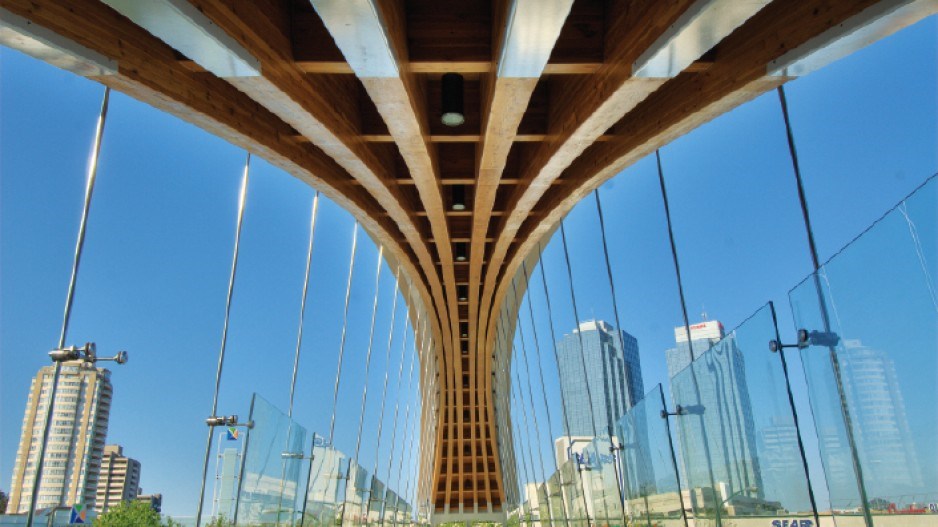BC's value-added wood sector makes a variety of products, from plywood to pre-fab homes to cabinets and furniture.
But when it comes to making one of the most cutting-edge products in the wood-construction world, B.C. has only one manufacturer.
Penticton-based Structurlam Wood Products makes cross-laminated timber (CLT) panels, an engineered-wood product that is relatively new, and is only just now making inroads into the North American building scene.
"We went to Europe in 2007 and saw for the first time ever these cross-laminated timber panels, and thought, 'Would these work in North America?'" said Bill Downing, president of Structurlam. "We spent several years researching it before deciding to make the jump."
Proponents of the material, like the Forest Products Association of Canada (FPAC), are pushing for Canadian companies to get into the business of making CLT and other engineered-wood products.
That's because those products can be used to build taller wood buildings than conventional lumber. In some cases, engineered wood can be used instead of concrete and steel.
But, currently, Canada is far from the forefront of making the products. Only one other Canadian company, Quebec's Nordic Engineered Wood, makes CLT.
"The really cool stuff is in Europe and coming out of a few of the Asian companies as well," said Isabelle Des Chenes, vice-president of market relations with FPAC.
As Structurlam's story shows, manufacturers of the high-tech material face several barriers in setting up shop in Canada.
The first is cost: the company spent millions to open a new plant in Okanagan Falls and outfit it with robotics able to do the precise design work. Previously, the 50-year-old company had manufactured another engineered wood product – glulam beams.
Next came finding a customer for the new product. Downing said Structurlam was lucky: the B.C. government's Wood First initiative, promoting the use of wood in publicly funded buildings, was introduced in 2009.
Demonstration projects developed by Natural Resources Canada and Forestry Innovation Investment, a provincial government agency, were also helpful.
"We had somewhere to put them as soon as we made them," said Downing. "That got people interested.
"We put on a heck of a lot of promotion, especially to architects … and engineers, so they could learn how to design with and use the product."
Because of the Wood First initiative, Stucturlam continued to find places for its product in university buildings and city halls. It is also supplying the Wood Innovation and Design Centre in Prince George, designed by tall-wood advocate Michael Green.
By the end of 2012, Downing said the company also started to find customers in the private sector. Structurlam provided CLT panels to three Western Budget Motels in Alberta, and an administrative building for an oil and gas company, also in Alberta.
"It's gone from demonstration, moved into public buildings, and into the private sector," said Downing.
While a budget motel may seem like a strange customer for the high-tech building material, Downing said it makes sense from a cost perspective, because buildings made of the panels take less time to put up.
"There are skilled-labour shortages in construction," said Des Chenes. "How can builders reduce cost? They're looking at modular solutions."
Des Chenes said it was unlikely that a large forest products company would move into manufacturing a product like CLT, which requires working closely with customers to manufacture the product to the client's specifications. Rather, those large lumber producers will play a role in providing the raw material.
"Smaller companies can be a bit more nimble and more willing to take the risk," she said. •
Up to code
The Forest Products Association of Canada (FPAC) and other wood-products advocates, like BC Wood and the Canadian Wood Council, are hopeful that changes to the Canada building code in 2015 will give engineered-wood manufacturers a boost.
B.C. has already changed its building code to allow for six-storey wooden buildings; Quebec and Ontario are set to do the same.
By 2020, the wood products industry hopes further changes to allow for even higher wooden buildings will be introduced into national building code. Changes are incorporated every five years, after new products have been extensively tested.




